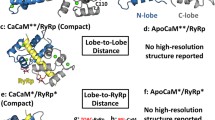Abstract
Atomic force microscope was applied to investigate the effect of extrinsic phospholipid on the structure of rabbit skeletal muscle ryanodine receptor/calcium release channel (RyR1). In addition, in the presence of extrinsic phospholipid, the height and elasticity of the RyR1s in different functional states were also measured. The results indicate: (i) most of the RyR1s showed a normal structure only in the presence of extrinsic phospholipid; (ii) treatment of the RyR1s with AMP and Ca2+ together could increase their Young’s Modulus but not change their apparent height; (iii) no detectable change in either height or Young’s Modulus of the RyR1s appeared, if the RyR1s were treated with other activators or inhibitors.
Similar content being viewed by others
References
Coronado, R., Morrissette, J., Sukhareva, M. et al., Structure and function of ryanodine receptors, Am. J. Physiol., 1994, 266(CellPhysiol. 35): C1485-C1504.
Sutko, J. L., Airey, J. A., Ryanodine receptor Ca2+ release channels: Does diversity in form equal diversity in function? 235 Physiol. Rev., 1996, 76(4): 1027–1071.
Serysheva, I. I., Orlova, E. V., Chiu, W. et al., Electron cryomicroscopy and angular reconstitution used to visualize the skeletal muscle calcium release channel, Nature Struct. Biol., 1995, 2(1): 18–24.
Radermacher, M., Rao, V., Grassucci, R. et al., Cryo-electron microscopy and three-dimensional reconstruction of the calcium release channel/ryanodine receptor from skeletal muscle, J. Cell Biol., 1994, 127(2): 411–423.
Sharma, M. R., Penczek, P., Grassucci, R. et al., Cryoelectron microscopy and image analysis of the cardiac ryanodine receptor, J. Biol. Chem., 1998, 273(29): 18429–18434.
Sharma, M. R., Jeyakumar, L. H., Fleischer, S. et al., Three-dimensional structure of ryanodine receptor isoform three in two conformational states as visualized by cryo-electron microscopy, J. Biol. Chem., 2000, 275(13): 9485–9491.
Shao, Z., Yang, J., Somlyo, A. P., Biological atomic force microscopy: from microns to nanometers and beyond, Annu. Rev. Cell Dev. Biol., 1995, 11:241–265.
Shao, Z., Yang, J., Progress in high resolution atomic force microscopy in biology, Qut. Rev. Biophys., 1995, 28(2): 195–251.
Neff, D., Tripathi, S., Middendorf, K. et al., Chloroplast F0F1ATP synthase imaged by atomic force microscopy, J. Struct. Biol., 1997, 119(2): 139–148.
Czajkowsky, D. M., Sheng, S., Shao, Z., Staphylococcal α-hemolysin can form hexamers in phospholipid bilayers, J. Mol. Biol., 1998, 276(2): 325–330.
Stoffler, D., Goldie, K. N., Feja, B. et al., Calcium-mediated structural changes of native nuclear pore complexes monitored by time-lapse atomic force microscopy, J. Mol. Biol., 1999, 287(4): 741–752.
Muller, D. J., Schoenenberger, C. A., Schabert, F. et al., Structural changes in native membrane proteins monitored at subnanometer resolution with the atomic force microscope: a review, J. Struct. Biol., 1997, 119(2): 149–157.
Wei, Q. Q., Chen, S. F., Cheng, X. Y. et al., Topography of skeletal muscle ryanodine receptors studied by atomic force microscopy, J. Vac. Sci. Technol. B., 2000, 18(2): 636–638.
Heinz, W. F., Hoh, J. H., Spatially resolved force spectroscopy of biological surfaces using the atomic force microscope, Trends Biotechnol., 1999, 17(4): 143–150.
Vinckier, A., Dumortier, C., Engelborghs, Y. et al., Dynamical and mechanical study of immobilized microtubules with atomic force microscopy, J. Vac. Sci. Technol. B., 1996, 14(2): 1427–1431.
Vinckier, A., Gervasoni, P., Zaugg, F. et al., Atomic force microscopy detects changes in the interaction forces between GroEL and substrate proteins, Biophys. J., 1998, 74(6): 3256–3263.
Vinckier, A., Semenza, G., Measuring elasticity of biological materials by atomic force microscopy, FEBS Lett., 1998, 430(1-2): 12–16.
Lai, F. A., Meissner, G., The muscle ryanodine receptor and its intrinsic Ca2+ channel activity, J. Bioenerg. Biomem., 1989, 21(2): 227–246.
Meissner, G., Adenine nucleotide stimulation of Ca2+-induced Ca2+ release in sarcoplasmic reticulum, J. Biol. Chem., 1984, 259(4): 2365–2374.
Xu, L., Tripathy, A., Pasek, D. A. et al., Ruthenium red modifies the cardiac and skeletal muscle Ca2+ release channels (ryanodine receptors) by multiple mechanisms, J. Viol. Chem., 1999, 274(46): 32680–32691.
Chu, A., Daiz-Munoz, M., Hawkes, M. J. et al., Ryanodine as a probe for the functional state of the skeletal muscle sarcoplasmic reticulum calcium release channel, Mol. Pharm., 1990, 37(5): 735–741.
Liu, W., Meissner, G., Structure-activity relationship of xanthines and skeletal muscle ryanodine receptor/Ca2+ release channel, Pharmacology, 1997, 54(3): 135–143.
Meissner, G., Rios, E., Tripathy, A. et al., Regulation of skeletal muscle Ca2+ release channel (ryanodine receptor) by Ca2+ and monovalent cations and anions, J. Biol. Chem., 1997, 272(3): 1628–1638.
Wagenknecht, T., Grassucci, R., Berkowitz, J. et al., Cryoelectron microscopy resolves FK506-binding protein sites on the skeletal muscle ryanodine receptor, Biophys. J., 1996, 70(4): 1709–1715.
Wagenknecht, T., Radermacher, M., Grassucci, R. et al., Locations of calmodulin and FK506-binding protein on the 236 three-dimensional architecture of the skeletal muscle ryanodine receptor, J. Biol. Chem., 1997, 272(51): 32463–32471.
Orlova, E. V., Serysheva, I. I., Heel, M. V. et al., Two structural configurations of the skeletal muscle calcium release channel, Nature Struct. Biol., 1996, 3(6): 547–552.
Serysheva, I. I., Schatz, M., Heel, M. V. et al., Structure of the skeletal muscle calcium release channel activated with Ca2+ and AMP-PCP, Biophys. J., 1999, 77(4): 1936–1944.
Wu, Y., Hamilton, S. L., Functional interactions of cytoplasmic domains of the skeletal muscle Ca2+ release channel, Trends Cardiovasc. Med., 1998, 8(7): 312–319.
Lai, F. A., Meissner, G., Purification and reconstitution of the ryanodine-sensitive Ca2+ release channel complex from muscle sarcoplasmic reticulum, Meth. Mol. Biol., 1992, 13: 287–305.
Ma, J., Desensitization of the skeletal muscle ryanodine receptor: evidence for heterogeneity of calcium release channels, Biophys. J., 1995, 68(3): 893–899.
Copello, J. A., Barg, S., Onoue, H. et al., Heterogeneity of Ca2+ gating of skeletal muscle and cardiac ryanodine receptors, Biophys. J., 1997, 73(1): 141–156.
Author information
Authors and Affiliations
Corresponding author
Rights and permissions
About this article
Cite this article
Qingqing, W., Xiaoyang, C., Keying, C. et al. Atomic force microscopy study of the rabbit skeletal muscle ryanodine receptors in different functional states. Sci. China Ser. C.-Life Sci. 45, 225–236 (2002). https://doi.org/10.1360/02yc9025
Received:
Revised:
Issue Date:
DOI: https://doi.org/10.1360/02yc9025




